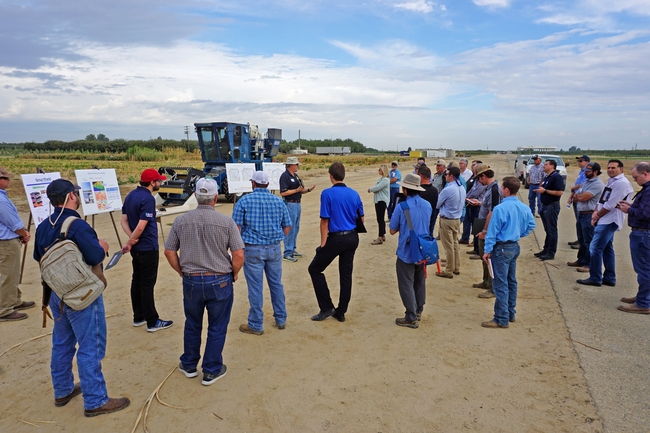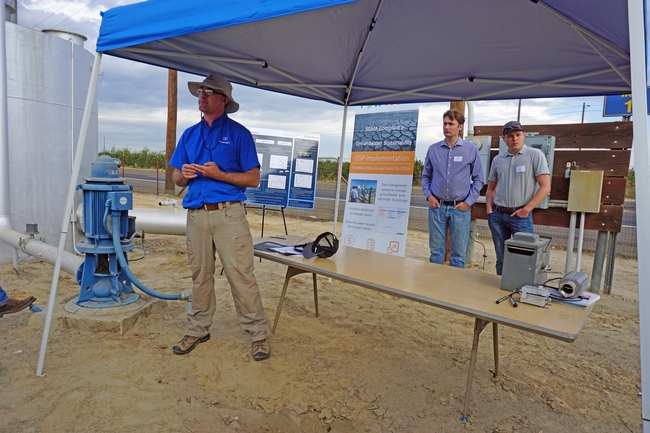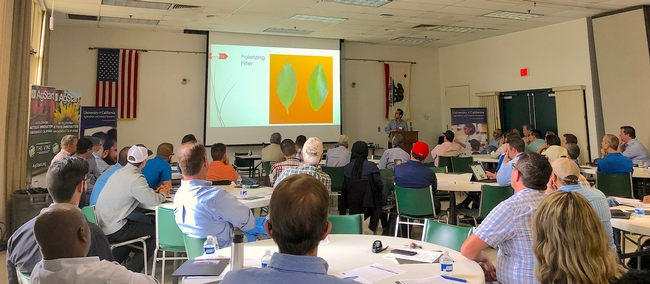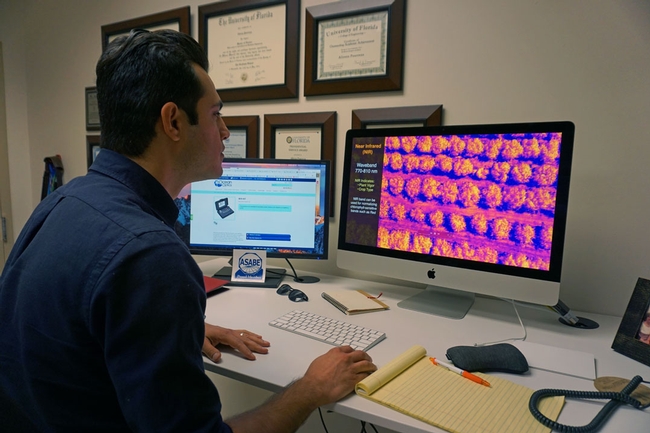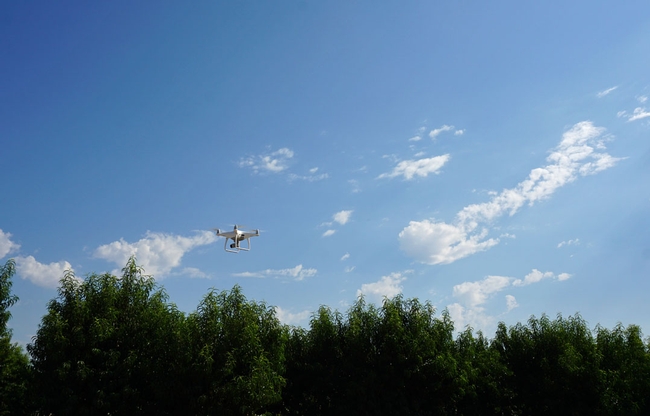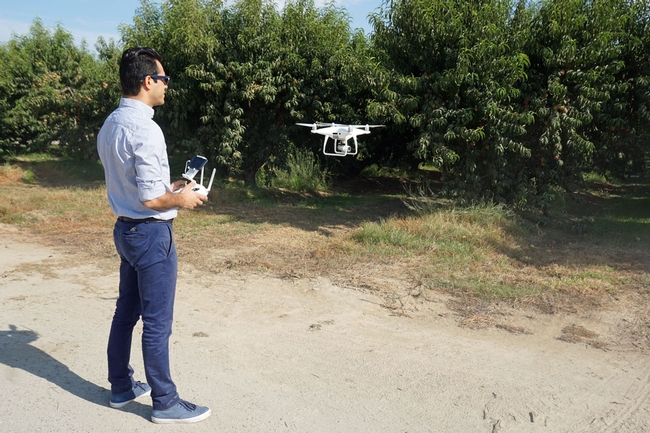Posts Tagged: Ali Pourreza
Open Farm 2018 and UC ANR promote ag technology
A torrent of technology is flowing into the agricultural sector. To make sense of it, UC Agriculture and Natural Resources, Fresno State and West Hills Community College came together with technology vendors and growers at Open Farm 2018, held in October at UC ANR's Kearney Agricultural Research and Extension Center in Parlier.
“A lot of technology is coming out,” said Kearney director and UC Cooperative Extension agronomy specialist Jeff Dahlberg. “I need to caution you, it's not all is based on science. We are helping with testing.”
Dalhberg has been working with Blue River Technologies to monitor the growth of dozens of sorghum cultivars. Throughout the growing season, Blue River flew drones over the sorghum nursery with cameras to capture their growth and development.
“We have a huge phenotypic dataset,” Dalhberg said. “It will be compared at the genetic level with plant samples and help us identify genes associated with drought tolerance.”
At Open Farm, Dahlberg's field presentation was paired with Smartfield, a company that uses fixed cameras and field sensors to gather information for “big data crunching.”
PowWow Energy, based in San Francisco with a field office at the Water, Energy and Technology (WET) Center at Fresno State, met near a well at Kearney to explain how the company can help growers with decision support tools. The company believes their technology will be useful for farmers tracking groundwater usage, data that will be key to complying with new rules associated with the Sustainable Groundwater Management Act (SGMA). SGMA, signed by Gov. Brown in 2014, gives local agencies the authority to manage groundwater in a way that achieves sustainability by 2042.
UCCE agriculture mechanization specialist Ali Pourezza introduced a prototype he developed with junior specialist German Zuniga-Ramirez that he believes will make early detection of the devastating citrus disease huanglongbing as easy as taking a photo with a smartphone camera.
The idea is based on the optical characteristics of the disease in leaves. By using a polarizing light, leaves on diseased trees are immediately identified. Infected trees can then be torn out before insects have the chance to spread the disease to other trees.
Pourezza and Zuniga-Ramirez are seeking funding to take the prototype to the next level, and eventually commercialize the product.
This sampling of innovations being showcased at Kearney is part of a continuing effort by UC to connect the ag community with technology developers and resources that is shepherded by a new UC ANR program called The VINE, Verde Innovation Network For Entrepreneurship. The VINE was created by UC ANR in 2017 to link entrepreneurs with mentors, advisors, collaborators, events, competitions and education.
At Open Farm 2018, UC ANR vice president Glenda Humiston was the keynote speaker. She outlined three areas where farmers, the technology sector and academia can work together to accelerate technology application in rural parts of California: improve broadband access, identify high-value uses for biomass and establish water infrastructure in rural communities.
To address the broadband issue, Humiston is leading an initiative to document mobile internet speed across California – including rural areas. In April 2019, Humiston plans to enlist 4-H members across the state to test internet speed using the free smartphone app CalSpeed several times over a period of a week.
“This will give us a snapshot of mobile broadband service availability,” Humiston said.
The crisis in the Sierra Nevada – where millions of trees died from the drought of 2010-16 – could prompt the development of high-value uses of biomass and establish a market for biomass derived in the agricultural sector, she said.
Humiston also took the opportunity to ask participants to help make sure the critical services UC ANR provides – including county-based UC Cooperative Extension, nine research and extension centers, the UC integrated pest management program, 4-H youth development, UC Master Gardeners and others – continue to fuel the California economy. Diminished funding from the State of California is taking a toll on the UC ANR budget.
“We need people like you to work with the VINE to set up improved support,” Humiston said.
UC scientist gives orchards a whole new color scheme
For centuries, farmers have used all the colors of the rainbow to assess their orchards: The bright pink of blossoms in springtime, the vibrant green of heathy leaves, the red blush on fruit ready to harvest.
However, there are wavelengths beyond what a human eye can see that also provide valuable information about the crop – including tree vigor, plant stress, water use and fertilizer needs.
UC Cooperative Extension agricultural engineering advisor Ali Pourreza is peering into these previously invisible colorations to create a virtual orchard that will quickly, easily and inexpensively allow farmers and scientists to manage orchards for optimum production.
To develop his first virtual orchards, Pourreza launched a camera-equipped drone over an orchard at the UC Kearney Agricultural Research and Extension Center in Parlier. As the drone flies over the trees, it snaps thousands of photos and, using photogrammetry and software that stiches the images together, makes a three-dimensional point cloud model of the orchard.
A computer program can make colors that are invisible to the human eye – such as near infrared, red edge and ultraviolet – into imagery that illuminates key crop health indicators. Near infrared indicates the amount of healthy foliage, plant vigor and crop type. If the trees have low near infrared values, it means the plants are under stress. Red edge indicates plant stress and nitrogen content. High red edge values indicate nitrogen stress and low water content in plant tissues.
Patrick Brown, a pomology professor at UC Davis, is planning to use the virtual orchard to map nitrogen use in citrus.
“We are currently working on developing models to help growers determine their fertilization demands and have been contrasting the results from real orchards with the virtual orchard,” Brown said. “We have already utilized the approach to contrast the estimates of tree growth and yield with whole tree excavations and harvests to help validate the virtual approach and provide a more accurate estimate of tree nitrogen demand.”
Ultimately, Brown hopes to develop a way for growers to rapidly and cheaply estimate the nitrogen demand of their orchards, monitor the status of their orchards and manage nitrogen fertilizer applications.
In addition to the color variations brought to light by the virtual orchard, the system provides detailed data on other aspects of the crop development.
“We can learn canopy height and width, the spacing between the trees, total leaf area, canopy density and the amount of shaded area in the orchard,” Poureza said.
This data is of interest to scientists studying plant development, soil health and irrigation.
For example, UCCE agricultural water management specialist Daniele Zaccaria is researching the impact of soil-water salinity on water use by pistachio trees in the San Joaquin Valley.
“In our on-going research study we are characterizing the functional relationships between soil-water salinity, canopy size and density and evapotranspiration of pistachio trees through the light interception by the canopy,” Zaccaria said. “We plan to work with Ali to see how the virtual orchard approach can represent that and simulate the physical process of soil evaporation and tree transpiration as a result of different canopy sizes and densities intercepting different amounts of solar radiation.”
Zaccaria said he also plans to deploy a similar approach to understand how different canopy sizes, planting densities and row orientations found in commercial citrus orchards in the San Joaquin Valley – from navel oranges, to mandarins and lemons – can affect the citrus water demand and use.
In addition to the rich data that scientists can glean from the virtual technology, Pourreza envisions many applications of this technology for farmers, including yield forecasting, blossom mapping, variable pesticide application and robotic harvesting.


